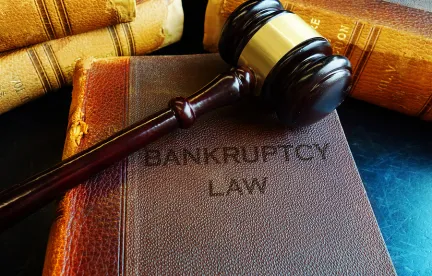Businesses struggle and bankruptcies are filed for a number of reasons, regardless of the economic climate. While unfortunate, this provides opportunities for others to purchase assets of distressed companies through the bankruptcy process. A sale under Section 363 of the United States Bankruptcy Code ("Section 363 Sale") can provide a useful tool for distressed companies seeking to sell their assets and a potential opportunity for buyers to purchase the assets at bargain prices. But, purchasing assets from a bankrupt company requires an understanding of the process and careful planning.
This article provides a brief overview of a typical Section 363 Sale process, recognizing that each case is different and each bankruptcy court has its own procedures.
Sale Process
The Section 363 Sale process in bankruptcy is straightforward. The debtor, like any seller, first markets its assets to possible purchasers. Assuming one or more potential purchasers makes an offer to purchase the debtor's assets, the debtor then selects what it considers the highest or best bidder to act as the "stalking horse" bidder. The debtor and the stalking horse bidder then negotiate an asset purchase agreement addressing the terms of the sale. After a tentative asset purchase agreement is executed with the stalking horse bidder, the debtor files a motion with the bankruptcy court seeking approval of a sale of the debtor's assets at a bankruptcy auction and of the bid procedures that will govern the rules and process of the ensuing auction.
Bid procedures generally are intended to encourage competitive bidding in order to maximize the value of the assets. The procedures describe the scheduling and notice of the auction and a deadline for prospective buyers to submit bids. The procedures also include provisions to address the risk to the stalking horse bidder that it may be outbid at the auction, such as allowing for the stalking horse bidder to receive a "break-up fee" and expense reimbursement, and requiring minimum bid increments (e.g., how much higher a subsequent bid must be in order to defeat the stalking horse bidder's offer). The debtor and the stalking horse bidder negotiate these bid procedures and may seek and receive input from others, including secured creditors.
When the debtor files its motion with the bankruptcy court seeking approval, the motion may include a request for an expedited hearing to consider the bid procedures. If the court grants the request to expedite, the court may approve the procedures within several days. The debtor then notifies its creditors and potential bidders of the auction. Normally, the time period for submitting bids is 20 to 30 days after the bankruptcy court approves the bid procedures. (The process may be shorter or longer depending on the type of assets or the circumstances present in the case.) However, the process should provide adequate time for the debtor to provide bidders with due diligence information.
Once the court approval is obtained, notice has been provided, and bidding closes, the auction is held. The debtor selects the highest and best bid at the auction. If there are no bidders for the assets other than the stalking horse bidder, the auction is cancelled and the stalking horse bidder is the successful bidder.
The next step is for the debtor is to seek the bankruptcy court's approval to sell its assets to the successful bidder. The debtor must establish that there is a sound business purpose for selling its assets. Creditors and other parties in interest are entitled to object to the sale. The bankruptcy court is required to consider the interests of all parties (including whether the asset is increasing or decreasing in value) in determining whether or not to approve the sale of the debtor's assets pursuant to the auction.
Benefits and Risks
A properly conducted Section 363 Sale benefits all major parties in a bankruptcy case. Debtors fulfill their fiduciary duty to maximize the value of their assets for their creditors. Secured creditors know that if the sale has been conducted according to procedures approved by the bankruptcy court, the best price has been obtained to maximize proceeds available to pay creditors. Also, each secured creditor has the option to "credit bid"—that is, offer cancellation of some or all of the debt owed by the debtor to the creditor as the creditor's bid. Unsecured creditors sometimes can negotiate a carveout from proceeds of a secured creditor's collateral. Buyers acquire the assets free and clear of liens or other claims and obtain other protections, such as a finding that the sale was in good faith. Individual creditors also have the opportunity for the buyer to assume certain contracts, thereby curing any defaults under those contracts.
Of course, there are some negatives and risks. For one, the terms of the deal are public. Further, affected parties are included in, and may complicate, the negotiations of the stalking horse bid and the bid procedures. In addition, buyers need to understand their offers typically will be subject to higher and better bids, meaning that the buyers run the possible risk of being outbid.
Perhaps one of the biggest risks is that an improperly conducted Section 363 Sale will not be approved by the Bankruptcy Court.
Consider our friend and very good client, Bob, who owns a boat manufacturing company. His business has faced many ups and downs over the years, but he is faring better than his competitors because he is always looking for opportunities. He recently learned that a competitor was having a tough time and was contemplating bankruptcy. For Bob, this was an opportunity to acquire assets for a bargain and diversify his product offerings. So, Bob struck a deal with the competitor and the competitor's lender to purchase the assets through a bankruptcy for less than 25% of the assets' market value. Not only would he get a steal, but the diversification would help his business weather the bumps of an uncertain market. Good deal for all, right?
Unfortunately, Bob didn't follow the Section 363 Sale process closely enough and the bankruptcy court denied the proposed sale. Why? Because Bob got greedy when he struck a deal with the competitor and its lender and they avoided the competitive bidding allowed under the Section 363 Sale procedures. The bankruptcy court ruled that the proposed process would chill the bidding and prevent the creditors from getting full value for the sale of the assets. What's more, because Bob and the competitor chose not to implement the stalking horse concept, and Bob was not identified as the stalking horse bidder, Bob was not able to recoup the time and money he spent in trying to put the deal together.
Conclusion
Commercial bankruptcies provide opportunities for buyers who understand the sale process to purchase assets of a distressed company at a bargain price. However, the flexibility and efficiency afforded by Section 363 Sales are not without limits or risks. While Section 363 Sales are used frequently, the process requires an appropriate evidentiary showing and careful planning to ensure the buyer obtains the benefit of its bargain.





 />i
/>i
